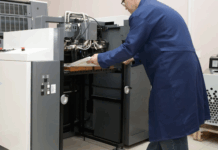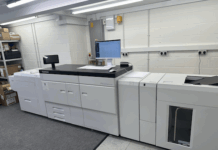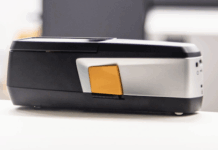The longevity and success of the Epson brand was made possible through the support and loyalty to its products and services. The Epson 50th anniversary logo expresses the company’s gratitude, and determination to continue to be a globally trusted brand.
As a company, Epson traces its roots back to 1942 and the watchmaking industry. For more than eight decades, Epson have continued to advance the efficient, compact and precise technologies that it first developed for watches and that have become a part of the DNA that has been passed down from generation to generation.
Epson launched its first information equipment product, the compact and lightweight EP-101 digital electronic printer, in 1968. It was this printer that served as the impetus for the creation of the Epson brand, in 1975. The brand name reflects the company’s hopes of preserving the value of the electronic printer (‘EP’) while continuing to create many valuable derivatives (‘SONs’). This brand embodies a desire to capitalise on its unique efficient, compact and precise technologies to deliver innovative products and services that provide value to people around the world.
Printing Solutions
This desire was realised with the launch of a compact and lightweight computer printer. Years of effort eventually culminated, in 1993, with the release of the MJ-500, an inkjet printer equipped with Epson’s proprietary Micro Piezo ink ejection technology. The following year, Epson launched the MJ-700V2C, the world’s first printer to deliver high-resolution (720dpi) at an affordable price. Epson was thus instrumental in creating a new culture of printing high-quality photos at home. Later, in 2010, feedback from business users in emerging markets convinced the company to develop and launch a printer equipped with high-capacity ink tanks.
Micro Piezo technology continued to evolve, with Epson developing next-generation printhead technology called ‘PrecisionCore’. PrecisionCore has made it possible to develop a wide range of products, not only for the home and office but also for commercial and industrial applications. Epson’s printheads are recognised for their outstanding quality and, in addition to Epson printers, are widely used in third-party printers.
In the commercial and industrial printing sectors, the company entered the large format printer market for professional graphic applications in 2000.
Visual Communications
The liquid crystal technology Epson initially developed for LCD watches found use in a new application: projectors. The company’s first projector was the VPJ-700, a compact full-colour LCD video projector released in 1989. This was followed, in 1994, by the ELP-3000, which delivered triple the brightness of conventional models despite its compact and lightweight design. These projectors, coupled with a PC, gained wide use in business presentations.
At the heart of these and subsequent projectors are high-temperature polysilicon (HTPS) panels, crucial devices that determine the performance of a projector. Epson’s HTPS panels are produced using advanced microfabrication technology like that used in semiconductor fabrication. Its unique design structure enables bright images of exceptional quality.
Manufacturing-Related And Wearables
Since its founding, the company has worked to enhance the production efficiency of its first business – watch manufacturing – by streamlining design, introducing division of labour in assembly (belt-line system), and promoting automation, and have also independently developed and introduced its own robots into manufacturing. In 1983, Epson launched the SSR-H Series, a horizontal articulated (SCARA-type) model with a compact size, high precision, and high-speed operation. Epson’s SCARA robots are built as part of comprehensive factory automation (FA) systems that integrate various devices, controllers, and more. These systems are widely used as production equipment across a broad range of industries, including automotive, electronics, food and medical industries, etc.
Epson have always been driven by a spirit of creativity and challenge. In 1969, with the goal of providing more accurate timepieces, it developed the world’s first commercial quartz watch. In 1982, the introduced a TV watch, and in 1988, developed a self-winding quartz watch. Even today, it continues to develop and manufacture quartz watches and mainspring-driven watches that achieve high accuracy comparable to quartz watches. Meanwhile, Seiko Epson acquired mechanical watch manufacturer Orient Watch Company in 2009 and owns the Orient Star and Orient brands.
Epson also developed quartz crystal devices for the world’s first quartz watch. Today, these tiny, low-power devices are used as high-accuracy timing devices in smartphones and wearable products as well as in applications that require precise measurement of position, attitude, and speed.
Global Presence
Epson has established production and sales sites around the world in order to deliver value to customers through its products and services. Its overseas expansion began in 1968 with the manufacture of watch cases in Singapore. The company have since expanded production globally and have major sites in China, Indonesia, and the Philippines. These sites both strengthen cost competitiveness and improve its ability to respond to the needs of international markets.
On the other hand, Epson established its first overseas sales company in 1975, in the U.S. Epson America served as a strategic first step for responding to the rapidly growing computer market at the time and to accelerate global business development. In 2023, the company established a sales company in Dubai, United Arab Emirates, to better serve and accelerate our expansion in the fast-growing emerging markets in the Middle East, Africa, Central Asia and surrounding markets.
Today, the company and the Epson brand are recognised around the world. This recognition has been earned largely as a result of a staunch commitment to advancing the efficient, compact and precise technologies that are an integral part of Epson’s DNA. These technologies are being deployed in a diverse range of products. They are found in multifunction office printers, in large format inkjet printers for advertisements, posters, photographic works and other professional graphic applications, and in digital textile printers – including ones used for articles appearing in the Paris Collection. They are also found in projectors, which have evolved from use in business presentations to use in major exhibitions and events. Meanwhile, robots are expanding their range of uses outside of manufacturing, and collaborative robots designed to work safely alongside humans are also being developed to automate steps and processes in the life sciences and in research institutes. Its crystal devices are used not only for timing control but also as crucial components in the attitude control of drones and agricultural machinery and in the monitoring of social infrastructure.
Going forward, Epson will continue to cherish and take pride in the Epson brand and will reward its customers and partners for their trust by living up to the corporate purpose: ‘Our philosophy of efficient, compact and precise innovation enriches lives and helps create a better world.’
Note: The product model names listed are the names used for products released in Japan at the time.
EPSON SOUTH AFRICA
www.epson.co.za





















